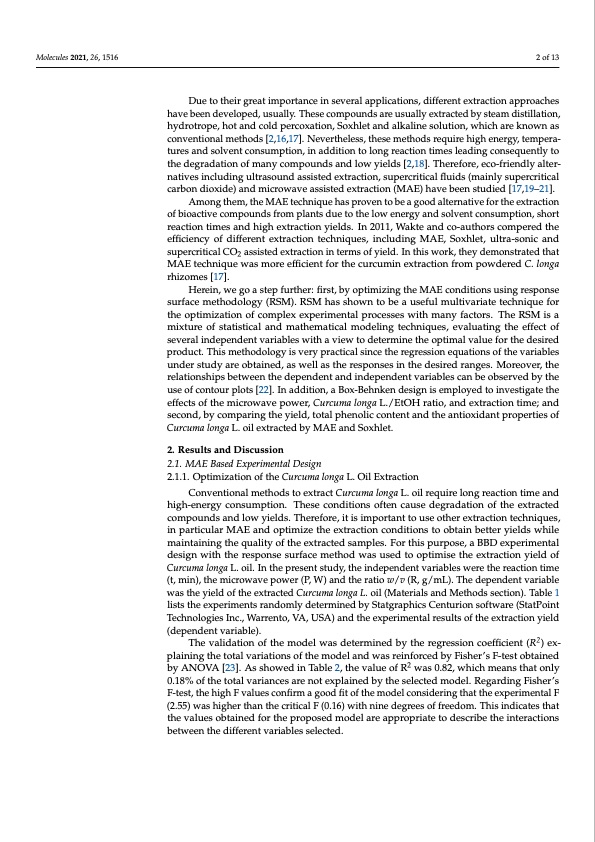
PDF Publication Title:
Text from PDF Page: 003
Molecules 2021, 26, 1516 2 of 13 Due to their great importance in several applications, different extraction approaches have been developed, usually. These compounds are usually extracted by steam distillation, hydrotrope, hot and cold percoxation, Soxhlet and alkaline solution, which are known as conventional methods [2,16,17]. Nevertheless, these methods require high energy, tempera- tures and solvent consumption, in addition to long reaction times leading consequently to the degradation of many compounds and low yields [2,18]. Therefore, eco-friendly alter- natives including ultrasound assisted extraction, supercritical fluids (mainly supercritical carbon dioxide) and microwave assisted extraction (MAE) have been studied [17,19–21]. Among them, the MAE technique has proven to be a good alternative for the extraction of bioactive compounds from plants due to the low energy and solvent consumption, short reaction times and high extraction yields. In 2011, Wakte and co-authors compered the efficiency of different extraction techniques, including MAE, Soxhlet, ultra-sonic and supercritical CO2 assisted extraction in terms of yield. In this work, they demonstrated that MAE technique was more efficient for the curcumin extraction from powdered C. longa rhizomes [17]. Herein, we go a step further: first, by optimizing the MAE conditions using response surface methodology (RSM). RSM has shown to be a useful multivariate technique for the optimization of complex experimental processes with many factors. The RSM is a mixture of statistical and mathematical modeling techniques, evaluating the effect of several independent variables with a view to determine the optimal value for the desired product. This methodology is very practical since the regression equations of the variables under study are obtained, as well as the responses in the desired ranges. Moreover, the relationships between the dependent and independent variables can be observed by the use of contour plots [22]. In addition, a Box-Behnken design is employed to investigate the effects of the microwave power, Curcuma longa L./EtOH ratio, and extraction time; and second, by comparing the yield, total phenolic content and the antioxidant properties of Curcuma longa L. oil extracted by MAE and Soxhlet. 2. Results and Discussion 2.1. MAE Based Experimental Design 2.1.1. Optimization of the Curcuma longa L. Oil Extraction Conventional methods to extract Curcuma longa L. oil require long reaction time and high-energy consumption. These conditions often cause degradation of the extracted compounds and low yields. Therefore, it is important to use other extraction techniques, in particular MAE and optimize the extraction conditions to obtain better yields while maintaining the quality of the extracted samples. For this purpose, a BBD experimental design with the response surface method was used to optimise the extraction yield of Curcuma longa L. oil. In the present study, the independent variables were the reaction time (t, min), the microwave power (P, W) and the ratio w/v (R, g/mL). The dependent variable was the yield of the extracted Curcuma longa L. oil (Materials and Methods section). Table 1 lists the experiments randomly determined by Statgraphics Centurion software (StatPoint Technologies Inc., Warrento, VA, USA) and the experimental results of the extraction yield (dependent variable). The validation of the model was determined by the regression coefficient (R2) ex- plaining the total variations of the model and was reinforced by Fisher’s F-test obtained by ANOVA [23]. As showed in Table 2, the value of R2 was 0.82, which means that only 0.18% of the total variances are not explained by the selected model. Regarding Fisher’s F-test, the high F values confirm a good fit of the model considering that the experimental F (2.55) was higher than the critical F (0.16) with nine degrees of freedom. This indicates that the values obtained for the proposed model are appropriate to describe the interactions between the different variables selected.PDF Image | Microwave-Assisted Extraction of Curcuma

PDF Search Title:
Microwave-Assisted Extraction of CurcumaOriginal File Name Searched:
molecules-26-01516-v2.pdfDIY PDF Search: Google It | Yahoo | Bing
CO2 Organic Rankine Cycle Experimenter Platform The supercritical CO2 phase change system is both a heat pump and organic rankine cycle which can be used for those purposes and as a supercritical extractor for advanced subcritical and supercritical extraction technology. Uses include producing nanoparticles, precious metal CO2 extraction, lithium battery recycling, and other applications... More Info
Heat Pumps CO2 ORC Heat Pump System Platform More Info
| CONTACT TEL: 608-238-6001 Email: greg@infinityturbine.com | RSS | AMP |